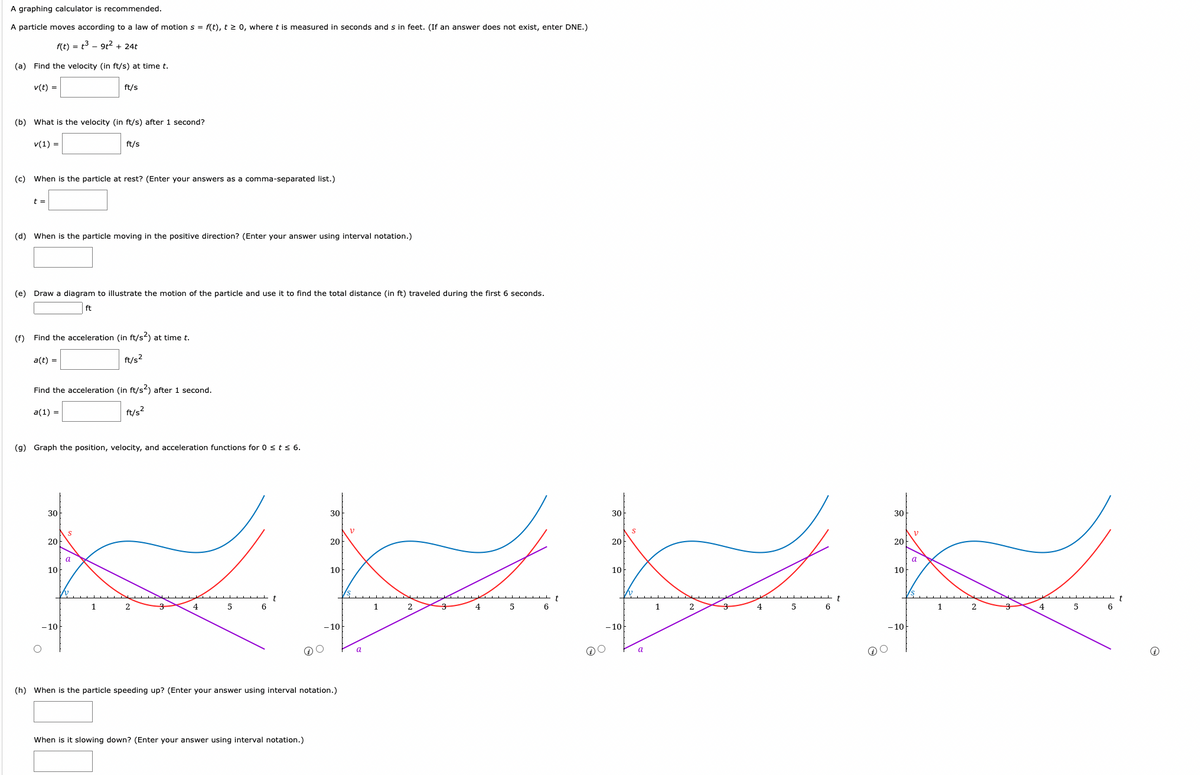A particle moves according to a law of motion s= f(t), tz 0, where t is measured in seconds and s in feet. (If an answer does not exist, enter DNE.) f(t)=³-9² +24t (a) Find the velocity (in ft/s) at time t. v(t) = ft/s (b) What is the velocity (in ft/s) after 1 second? v(1) = ft/s (c) When is the particle at rest? (Enter your answers as a comma-separated list.)
A particle moves according to a law of motion s= f(t), tz 0, where t is measured in seconds and s in feet. (If an answer does not exist, enter DNE.) f(t)=³-9² +24t (a) Find the velocity (in ft/s) at time t. v(t) = ft/s (b) What is the velocity (in ft/s) after 1 second? v(1) = ft/s (c) When is the particle at rest? (Enter your answers as a comma-separated list.)
College Algebra
7th Edition
ISBN:9781305115545
Author:James Stewart, Lothar Redlin, Saleem Watson
Publisher:James Stewart, Lothar Redlin, Saleem Watson
Chapter3: Polynomial And Rational Functions
Section3.1: Quadratic Functions And Models
Problem 56E: When a certain drug is taken orally, the concentration of the drug in the patient's bloodstream...
Related questions
Question

Transcribed Image Text:A graphing calculator is recommended.
A particle moves according to a law of motion s = f(t), t≥ 0, where t is measured in seconds and s in feet. (If an answer does not exist, enter DNE.)
f(t) = t³ 9t² + 24t
(a) Find the velocity (in ft/s) at time t.
v(t) =
(b) What is the velocity (in ft/s) after 1 second?
v(1) =
t =
(c) When is the particle at rest? (Enter your answers as a comma-separated list.)
(d) When is the particle moving in the positive direction? (Enter your answer using interval notation.)
(e) Draw a diagram to illustrate the motion of the particle and use it to find the total distance (in ft) traveled during the first 6 seconds.
ft
a(t) =
(f) Find the acceleration (in ft/s2) at time t.
ft/s²
ft/s
Find the acceleration (in ft/s²) after 1 second.
a(1) =
ft/s²
30
ft/s
(g) Graph the position, velocity, and acceleration functions for 0 ≤ t ≤ 6.
20
10
- 10
a
1
4
5
6
t
30
20
10
gg
t
5
6
1
-10
When is it slowing down? (Enter your answer using interval notation.)
30
20
10
- 10
(h) When is the particle speeding up? (Enter your answer using interval notation.)
a
1
2
4
a
2
4
5
6
30
20
10
-10
V
a
1
2
4
5
6
t
Expert Solution
This question has been solved!
Explore an expertly crafted, step-by-step solution for a thorough understanding of key concepts.
Step by step
Solved in 2 steps

Recommended textbooks for you

College Algebra
Algebra
ISBN:
9781305115545
Author:
James Stewart, Lothar Redlin, Saleem Watson
Publisher:
Cengage Learning


Algebra & Trigonometry with Analytic Geometry
Algebra
ISBN:
9781133382119
Author:
Swokowski
Publisher:
Cengage

College Algebra
Algebra
ISBN:
9781305115545
Author:
James Stewart, Lothar Redlin, Saleem Watson
Publisher:
Cengage Learning


Algebra & Trigonometry with Analytic Geometry
Algebra
ISBN:
9781133382119
Author:
Swokowski
Publisher:
Cengage

Trigonometry (MindTap Course List)
Trigonometry
ISBN:
9781337278461
Author:
Ron Larson
Publisher:
Cengage Learning
